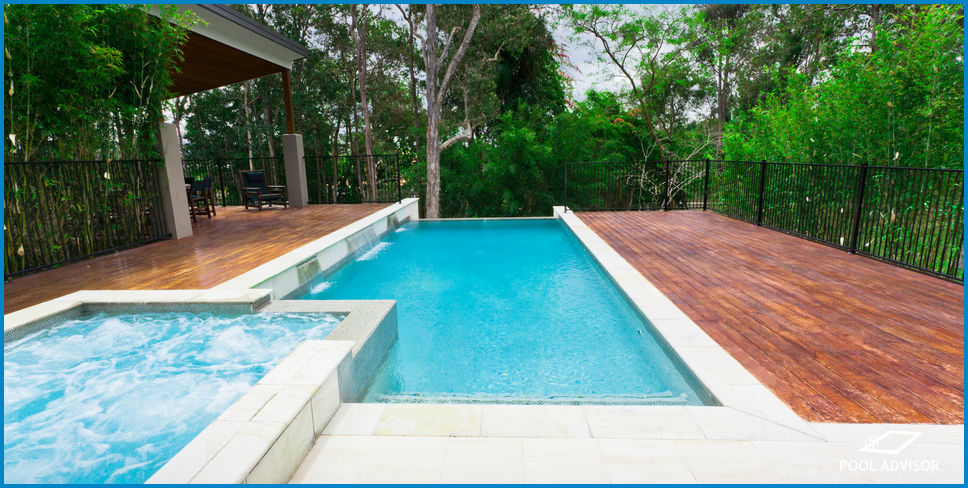
Black Spots In Your Pool Are Not Algae - But What Are They?
Many pool owners notice black spots forming on the lining of their pools and begin looking for an explanation. Unfortunately, most information available about black spots in your pool focus on black spot algae, which is not the only cause of this pattern.
Black spots in your pool that are not algae are typically caused by different types of stains, and these can vary based on the type of pool you have.
In this article we will talk about how you can make sure your black spots are not algae, the most likely other causes for these spots, and how to remove them from your pool.
Ruling Out Algae
Before taking steps to identify and treat your black spots, you will want to be absolutely sure that they are not composed of algae. This takes a small amount of effort, and can save you a lot of time and money in the treatment process.
To rule out algae, we recommend performing a scrub test. To perform this test, scrub the black spot in question with a stiff brush and crushed or granulated chlorine. After applying moderate effort, a black spot that is composed of algae will begin to break off in pieces.
While black spot algae is very durable and takes lots of effort to remove manually, a black spot that is not caused by algae will show almost no change at all even after considerable amounts of scrubbing.
Causes Of Black Spots In Pool Besides Algae
In most types of pool, black spots that are not algae are the result of a unique pattern of metal staining. There are also different types of metals that can produce the black colour that you see.
For example, these metal stains can contain high amounts of silver, which typically turns black during the tarnishing and oxidation process. This can be seen when sterling silver jewellery is worn in a chlorine pool!
Copper stains, though usually appearing somewhat green in colour, can also turn black if they experience a different type of oxidation that involves contact with acidic substances.
Iron and rust stains can also appear black, although this is more rare. Depending on the lighting conditions and the colour of your pool’s lining, stains that are typically more orange-brown in colour may appear black through the water.
If you have a fibreglass pool, black spots forming on the surface of your pool are often caused by cobalt oxide.
This type of stain occurs when pool chemicals have a reaction with traces of the cobalt contained in the fibreglass lining that are beginning to seep through the protective gel coating of the pool.
How To Remove Black Spot Stains From Your Pool
Black spots that are caused by various metal stains should be removed using a stain remover.
For concrete, pebblecrete, and vinyl pool linings, we recommend using Lo-Chlor Multi Stain Remover, which is effective on all types of metal stains. This eliminates the need to further diagnose the cause of your stains, and allows you to skip right to the treatment process.
If you have a fibreglass pool, you will want to use a different type of stain remover. We recommend a product specifically designed for removing black spot patterns from the gel-coated surface of fibreglass pools.
When using stain removers, be sure to follow all instructions provided by the product manufacturer to get the best results and ensure your safety.
Most stain removal products require that you remove most or all available chlorine from the pool before treatment. You can achieve this using a chlorine remover.
Preventing Black Spot Stains Caused By Metals
Metal staining occurs when dissolved metals in your water oxidise after they come in contact with pool chemicals, which then causes them to bind to the surfaces of your pool.
To prevent metal staining, you can add a solution to your pool that prevents these metals from oxidising and helps your filter work to remove them.
We recommend a metal remover, which effectively prevents metal staining and can also work to reduce the appearance of older stains. This product also prevents scale buildup caused by calcium, which is a nice bonus.
It’s also important to try to avoid adding metals to your pool in the first place. Try to avoid excessive use of copper-based algaecides, and remove any nails or other loose metal objects that may have fallen into your pool.
Conclusion
Black spots on the surface of your pool are not always caused by black spot algae. Sometimes, patterns of black spots can show up as a unique form of metal stains.
Although this condition has a unique appearance, the removal process is the same as with other patterns of metal staining.
Black spots that are not algae are especially common in fibreglass pools due to the components of the fibreglass seeping through the gel coating of your pool. As a common sign of an ageing fibreglass pool, if these spots recur often, it may mean that your pool needs attention from a specialist.
Do you have any questions about the black spots on your pool’s lining that are not algae? Let us know in the comments!

Louis
A chemical engineer by trade, Louis is committed to debunking myths in the pool industry by explaining the underlying chemistry and making it accessible to all.
